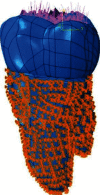Investigation of the Effects of Adhesive Materials of Different Types and Thicknesses on Dental Tissue Stress via FEM Analysis
- PMID: 35915790
- PMCID: PMC9338850
- DOI: 10.1155/2022/8493909
Investigation of the Effects of Adhesive Materials of Different Types and Thicknesses on Dental Tissue Stress via FEM Analysis
Abstract
The aim of this study was to investigate the types and thicknesses of adhesive materials used in restorative treatment in dentistry in class I occlusal and class II disto-occlusal cavities and to examine the effects of stress distribution on enamel, dentin, restoration material, and adhesive material using the finite element stress analysis method. A 3-dimensional geometry of the tooth was obtained by scanning the extracted 26 numbered upper molar tooth with dental tomography. The 3D geometry obtained by using the Geomagic Design X 2020.0 software was divided into surfaces, and necessary arrangements were made. With the Solidworks 2013 software, 2 different cavity modeling, class I occlusal and class II disto-occlusal, with a cavity angle of 95 degrees on the 3D model, as well as 10, 30, and 50 micrometers thick, four types of adhesive materials and the modeling of the bulk-fill composite material on it were made. With finite element stress analysis, the stress distribution was analyzed using the Abaqus software. The materials used in the study are included in the simulation as isotropic linear elastic. Periodontal ligament and jawbone were not included in the analysis. A total of 600 N pressure was applied on the models. In our study, it was observed that the amount of stress on the tooth structures changed when the thickness, elastic modulus, and Poisson ratios of the adhesive material were changed. In addition, when all models are examined, it is seen that when the thickness is increased, more stress is placed on the adhesive material compared to the restoration, while when 50-micrometer-thick adhesive material is used, more stress is placed on the restoration compared to the adhesive material.
Copyright © 2022 Hakan Yasin Gönder et al.
Conflict of interest statement
The authors declare that they have no conflicts of interest.
Figures















Similar articles
-
The influence of dental restoration depth, internal cavity angle, and material properties on biomechanical resistance of a treated molar tooth.J Mech Behav Biomed Mater. 2022 Sep;133:105305. doi: 10.1016/j.jmbbm.2022.105305. Epub 2022 Jun 6. J Mech Behav Biomed Mater. 2022. PMID: 35700676
-
Mechanical behavior of bulk direct composite versus block composite and lithium disilicate indirect Class II restorations by CAD-FEM modeling.Dent Mater. 2017 Jun;33(6):690-701. doi: 10.1016/j.dental.2017.03.014. Epub 2017 Apr 14. Dent Mater. 2017. PMID: 28413061
-
CAD-FE modeling and analysis of class II restorations incorporating resin-composite, glass ionomer and glass ceramic materials.Dent Mater. 2017 Dec;33(12):1456-1465. doi: 10.1016/j.dental.2017.10.010. Epub 2017 Nov 8. Dent Mater. 2017. PMID: 29128128
-
Stress distribution of bulk-fill resin composite in class II restorations.Am J Dent. 2017 Aug;30(4):227-232. Am J Dent. 2017. PMID: 29178706
-
Teeth Restored with Bulk-Fill Composites and Conventional Resin Composites; Investigation of Stress Distribution and Fracture Lifespan on Enamel, Dentin, and Restorative Materials via Three-Dimensional Finite Element Analysis.Polymers (Basel). 2023 Mar 25;15(7):1637. doi: 10.3390/polym15071637. Polymers (Basel). 2023. PMID: 37050251 Free PMC article.
Cited by
-
Multi-acrylamides improve bond stability through collagen reinforcement under physiological conditions.Dent Mater. 2024 Jun;40(6):993-1001. doi: 10.1016/j.dental.2024.05.002. Epub 2024 May 10. Dent Mater. 2024. PMID: 38729779 Free PMC article.
-
Stress Distribution Pattern in Class I Cavities Restored by Different Techniques According to the Stress Reducing Direct Composite Concept: A Finite Element Analysis.Int J Dent. 2025 Jun 4;2025:7196931. doi: 10.1155/ijod/7196931. eCollection 2025. Int J Dent. 2025. PMID: 40501491 Free PMC article.
References
MeSH terms
Substances
LinkOut - more resources
Full Text Sources

